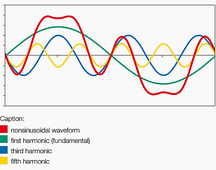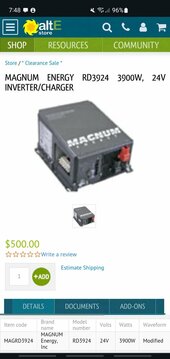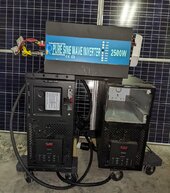Maybe your over thinking things and not trying things.
For better part of a decade I used an ancient SENDON 400 UPS to run back up on my sump pump.
That's a 400 watt rated UPS for electronics with a crude modified square wave inverter running thorough a transformer no less to drive a 1/4 hp sump pump...
It was a tank, I'd still be using it had my son no dropped a rag in the sump and a trace burned off the power board as the old inverter tried to repeatedly start the motor hours on end.
Some will say you that it was too small or the motor would not work or the it would damage things...
The only thing that Sendon was not good for was a computer back up because it was not fast enough to switch over to keep my PC on
Maybe rather than worry about what a thing can for you should try it out and see if its got any objectionable results.
It has been said here there are some rough starts and noise when using motors and such on modified sign inverters.
That's true...
Your going to get more heat and lower efficiency.
The MSW inverter
This image shows what happens when you add a triple harmonic to a pure sign wave ( in case folks don't understand I'm not trying to waste bandwidth with a physics lesson )

What you see is the yellow and blue sign wave super imposed on on the the green first harmonic.
These wave forms add and if you look at it and think about you can see where they add and where they cancel.
This is how we can create a square wave from pure sign waves!!!
And this is what a square wave really is its a mixture of different frequencies are odd numbers added together.
The effect of this is on electrical equipment can be heard as the loud hum in a motor or transformer.
These higher frequencies make sounds we hear and they cause abnormal pulses in torque and.
These higher frequencies cause losses in the motor because its not designed to effectively use the torque pulses and the iron lamination are not the correct thickness to reduce heating losses.
These can make a motor run too hot
if your loads are already near the peak power a machine can deliver then the extra heat and wasted power may cause a motor to overheat.
But most of the time we don't run things at peak power output do we?
So it your motor is not getting too hot and you can live with the objectionable sounds not worries.
There are other places in a power system with a lot of harmonics on it that these things can cause voltage spikes and higher corrent flows in wiring, mostly these are confined to three phase systems and large systems.
So try things ad observe...
Things right off the top I would not trust with a MSW inverter are modern electronics.
Generally they are disposable from the start and prone to fail with out any help form us by feeding them less digestible power.
Since realty important loads are known to be sensitive power spikes and fail at the worst times its probably a good idea to look at a power conditioner to protect your furnace or washing machine these days not just your TV or Micro wave.
I won't suggest brands or anything because thats up to you and how much your fear and mistrust your stuff
Many years ago I used to use a lot of SOLA transformers at work to protect our sensitive automation from lightening, switching transients and harmonics.
They would take dirty power and make it into clean power.
And Today we don't put these in or replace them as they fail ,mostly because we have been real lucky I guess or the electronics are better?
I couldn't say.

I can tell you after spending years on picket lines I could not care less how much it costs to blow up all the electronics where I work and don't bother too much raising alarm about bad power at work.
Sometimes I even torture things.
I am amazed how Toshiba TV sets can be poked with 5000 volt meggars and still function!
( just an example of what a bored electrician will do with TV set you took out of an office no one wants )
Modern electronics seem to be quite able to survive a lot of abuse and I figure as long as your TV set is OK with a MSW inverter its probably going to be fine for a long time...
So your Mileage may vary, as they say.
Maybe you never have a problem....
Maybe your stuff is such cheap crap it blows up without a wisper or sigh.
You can predict a failure anymore, but if its important like your Furnace perhaps your should not risk abusing the boards and electronics or even trust utility power without some kind of power conditioner.
Since I don;t trust most electronics I tend to unplug things I am not using like electronic washing machine if there is a thunderstorm....
The Chinese TV from Costco is so cheap and under warranty I don't bother.








